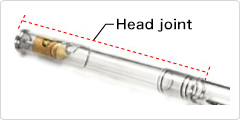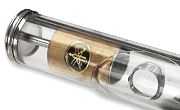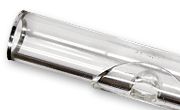The Structure of the Flute
[Experiment] replacing the cork in the head joint with a different material
Performing a sound experiment
Inserting natural cork in the head joint affects the sound quality. What will happen, however, if we insert another substance instead of cork?
Experiment steps
- Blow into the head joint alone.
- Remove the head screw and blow into the instrument.
- With the cork section replaced by polyethylene foam, blow into the instrument.
- With the cork section replaced by absorbent cotton, blow into the instrument.
- Using nothing to plug the tube, blow into the instrument.

Results of the experiment
Blowing into the head joint alone

Removing the head screw

Plugging with polyethylene foam

Plugging with absorbent cotton

Blowing into the head joint and body alone

As this was an experiment, the recorded pitches differed from the correct notes.
An acrylic flute was used in the experiment, so that the internal workings would be clearly visible. The image above showing blowing into the head joint alone refers to the sound produced when the instrument was played after the head screw alone had been removed from the head joint. The sound changed subtly. The image above showing plugging with polyethylene foam refers to removing the cork, which is secured with a screw, and replacing it with polyethylene foam. The impression was of a light sound with no substance-a ringing sound that lacked resonance. When the tube was then plugged with absorbent cotton, clearly the volume of the notes was lower and the player's breath was escaping.
Blowing into the head joint and body alone caused sound to be emitted from the left end of the instrument as well as the right, because nothing was used to plug the tube.
The overall pitch was also slightly higher. In a real flute, the head screw and the reflective plate clamp the cork from opposite sides, minutely adjusting its rigidity. The rigidity of the cork affects the timbre of the sound produced.
